Freshly made pesto is vastly superior to anything bought in a jar, which is why I never buy pesto and always make it myself from scratch. I’ve always used the ‘modern’ way of making pesto: in the food processor or blender. My Italian blogging buddy Tuttacronaca convinced me to try at least once to make it using the traditional method with mortar and pestle. And so I decided to do a side-by-side comparison. The word “pesto” has been derived from the word “pestle”. Making pesto in the food processor takes only a few minutes, whereas by hand with mortar and pestle it almost requires half an hour of hard work. So it’d better be worth it! Is it? Read on to find out!

Pesto alla Genovese is the original pesto from the city of Genova in Liguria. For this comparison of man versus machine I have used the official recipe of the Consorzio del Pesto Genovese that prescribes to use only basil, garlic, parmigiano, pecorino, pine nuts, extra virgin olive oil, and salt. When I was in the US I noticed that the basil there has a mint-like flavor that is different from the basil used in Liguria. Use Italian-style basil if you can for the original flavor.
Ingredients
For 450 ml (almost 2 cups) of pesto
75 grams (3 oz) basil leaves (no stems)
100 grams (3.5 oz) freshly grated parmigiano reggiano or grana padano
50 grams (1.75 oz) freshly grated pecorino (romano, toscano, sardo, or siciliano)
150 ml (2/3 cup) extra virgin olive oil, preferably ligurian
25 grams (1 oz) pine nuts
2-3 cloves garlic
2 pinches of coarse sea salt
Preparation with mortar and pestle
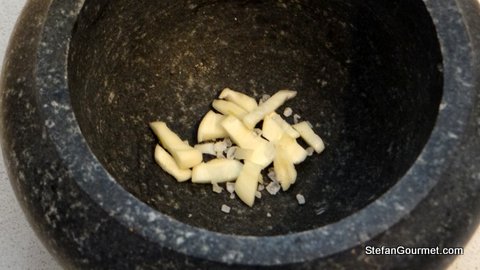
The consorzio says you should use a marble mortar (I used granite) and wooden pestle. Start with the garlic (coarsely chopped) and a pinch of coarse sea salt.
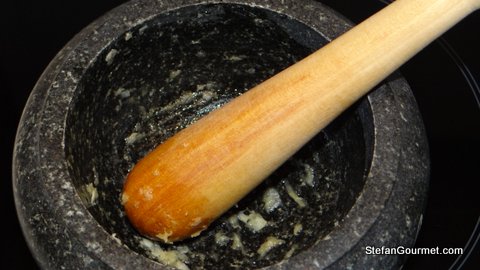
Grind this in to a smooth paste using a circular motion with the pestle. You can rotate the mortar in the opposite direction while you do this.
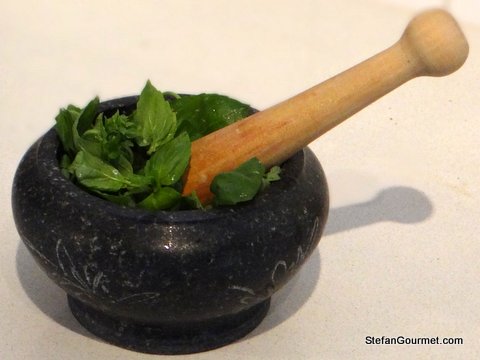
Add the basil leaves and a second pinch of coarse salt.
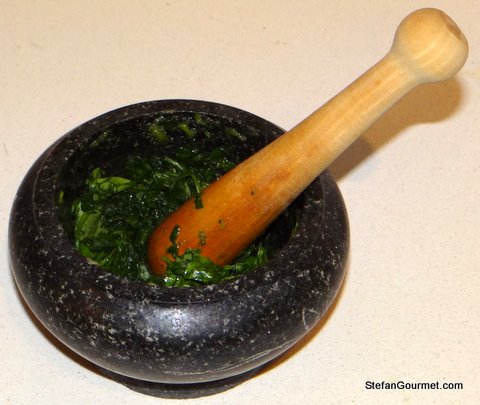
Grind the basil leaves against the side of the mortar.

Continue until the basil has been reduced to a smooth paste.
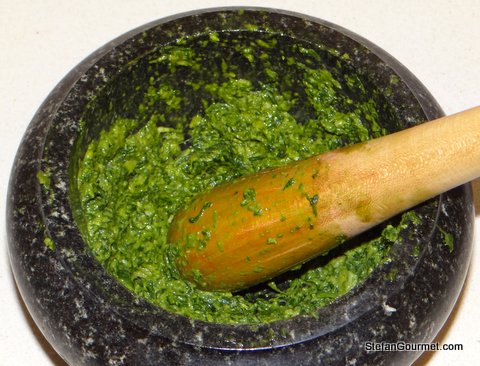
Grind the pine nuts with the pestle. I found it works best if you obliterate them one by one.
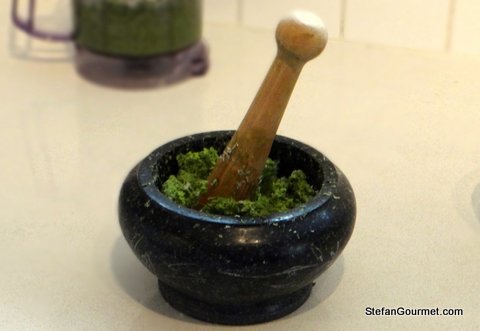
Keep grinding until you have worked in all of the cheese.
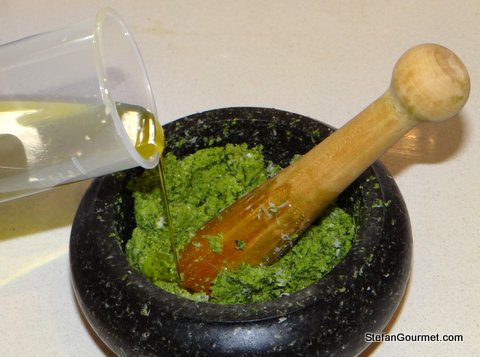
Add the olive oil slowly and keep grinding until all of it has been incorporated to finish your pesto made by hand.
The pesto should be made as quickly as possible to reduce oxidation as much as possible.
Preparation with food processor or blender
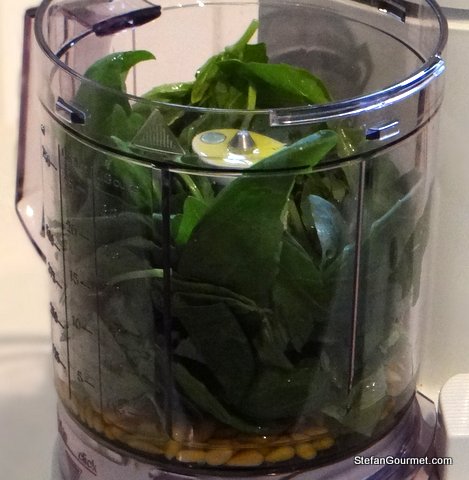
Put the basil, salt, garlic, pine nuts, and olive oil in the blender.
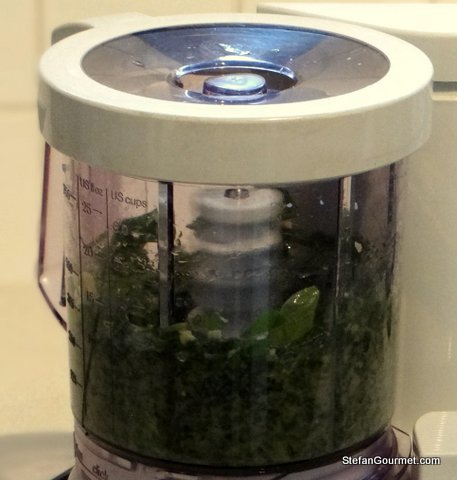
Process at low speed, stopping to scrape down the sides as necessary. Do not process longer than necessary to avoid warming up the pesto too much.
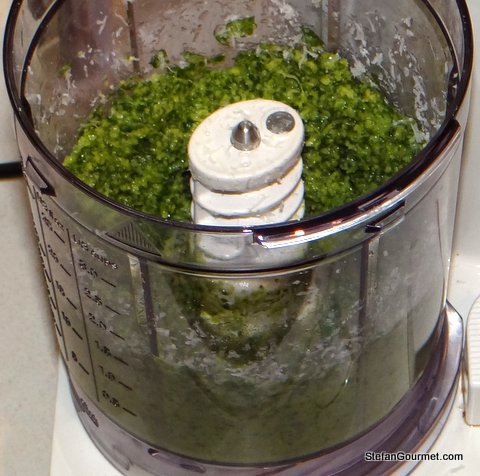
Process briefly to incorporate the cheese. You could also stir the cheese in by hand if the pesto is already becoming warm.
That’s all!
The verdict
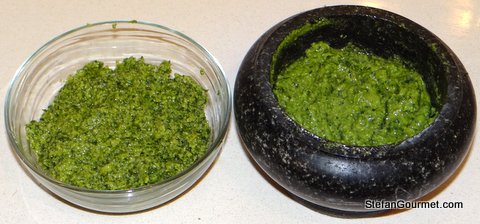
The hand-made pesto is more creamy than pesto made by machine, which is slightly more coarse. The biggest difference in the taste: the machine pesto tastes fine, but the mortar and pestle version is vastly superior! The taste is deeper and rounder, and less bitter. Pestle and mortar are better at getting all of the taste out of the leaves than the blender, which causes this difference. The difference is such that I will make my pesto by mortar and pestle from now on, meaning that I’ll probably have to make it during the weekend if I want to have it on a weekday because working a mortar and pestle for half an hour is not something I like to do when I get home from a long day at the office.
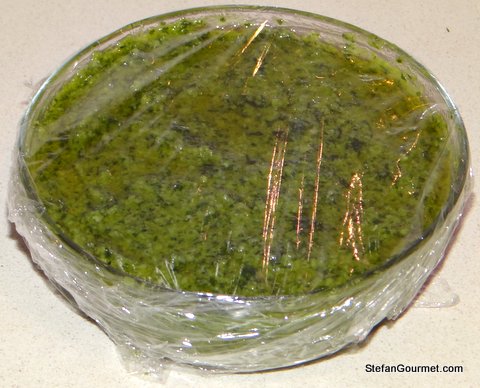
Luckily, pesto keeps well in the refrigerator if covered by a thin layer of olive oil in an airtight container (or tightly covered by plastic wrap).

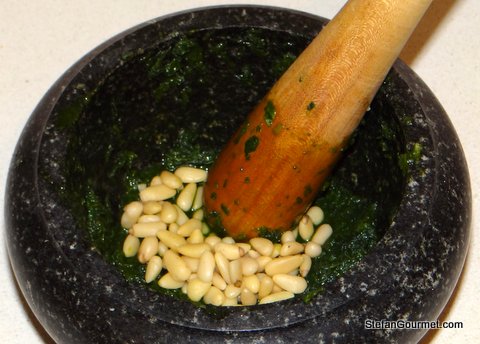
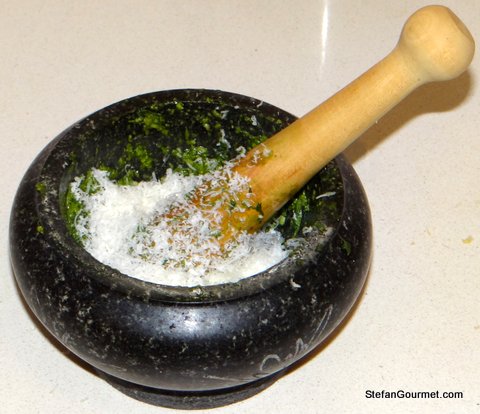
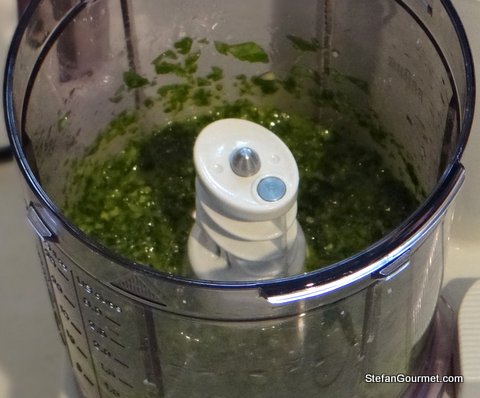
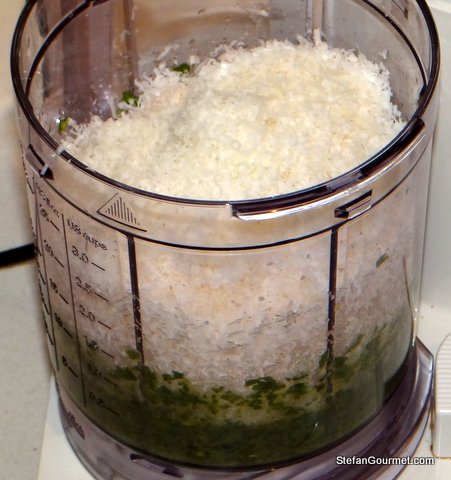

Great Stefan, you could try Basil Cress instead of the regular, more full grown basil. Yummy! And a nice change at that!
LikeLike
Thanks, Lisette. I’ll have to look for basil cress next time I’m at Hanos.
LikeLike
How are your biceps?!! I love this pesto experiment.
LikeLike
Luckily this more a work of patience than a work of force, since I don’t have biceps to speak of 😉
LikeLike
it looks just super delicious. I must try to make pesto that way. Maybe you also want to check my blog out?
LikeLike
Thanks. I’ll go have a look…
LikeLike
Great experiment … I was just thinking of making pesto this morning but the only fresh basil available looked a little past its best. I wish I had a nice mortar like yours… mine is much smaller 😦
LikeLike
Thanks, John. You definitely need the size I have to make the amount I just did — this was the limit I’d say.
LikeLike
I’ve always wanted to try making pesto from scratch and now, after looking at this post, I want to even more! One question – what happens if you use a granite or marble pestle? I don’t know if I have a wooden one. Thanks, Camilla
LikeLike
The Ligurians say to use a wooden one and I’m not sure why. It may just be tradition. It may be because a wooden pestle has a better grip, which is great since you will be using it for a while when you make this. I’m pretty sure it won’t have a large impact on the flavor, so you can make delicious pesto with a marble or granite pestle.
LikeLike
Thanks! Will give it a go 🙂
LikeLike
I was looking forward to this post!
I can see/agree with your verdict, “Pestle and mortar are better at getting all of the taste out of the leaves than the blender…”. A lesson from the ‘test kitchen’! Thank you for sharing.
LikeLike
You’re welcome 🙂
LikeLike
I like to use my mortar and pestle also.
LikeLike
I like the taste, but I don’t really like the work 😉
LikeLike
Great post! 🙂
LikeLike
Grazie 🙂
LikeLike
Grazie a te e… tanti auguri per una serena Pasqua! 🙂
LikeLike
Buona Pasqua!
Qui è più freddo di Natale. Forse avremo una pasqua bianca (I’m dreaming of a white Easter…)
LikeLike
Thanks for sharing your experiment Stefan. I make pesto to almost the exact same proportions as your recipe, but only ever in a machine. It may be time to change my method.
LikeLike
I was skeptical, but it really makes a difference!
LikeLike
Great test, Stefan, and I’ve had others tell me the same. If I ever get a larger mortar and pestle, I’ll give it a try. For now, though, I’ll opt for convenience. My taste buds don’t know what they’re missing and I’ll keep them in the dark for a while. 🙂
LikeLike
I was aware of that risk when I was doing this test. Oh well…
LikeLike
I admire your dedication to the art. But I also agree – after spending all day in an office hard graft in the kitchen isn’t so appealing.
LikeLike
Stefan, if you like pesto, you have to know about Roberto Panizza … the king of Pesto … here is one link to introduce him: http://gustiamo.typepad.com/gustiblog/2011/10/pesto-rossi.html
LikeLike
Thanks for the link
LikeLike
thanks for doing the experiment, now I know how to make a proper pesto 😉
LikeLike
You’re welcome. Hope you give it a try!
LikeLike
Nice comparison, Stefan. Given I am comfortably lazy in my later years, I doubt I would make pesto with a mortar and pestle but I’m glad you did the comparison for me. 😉 I am always intrigued by the various comparisons and techniques you employ. Well done.
LikeLike
Thanks, Richard. I am quite lazy too, but willing to put in the work if it really makes a difference. I may have to look into ways of improving the flavor of machine-made pesto 😉
LikeLike
Pesto is undoubtedly one of my favorite foods. I have a Persian garlic masher – similar to a mortar and pestle – so I will give the man-made version a try. This is a gorgeous pesto, Stefan. Lovely post!
LikeLike